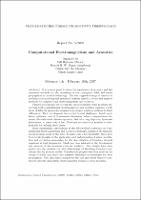Zusammenfassung
It is a moot point to stress the significance of accurate and fast numerical methods for the simulation of electromagnetic fields and sound propagation for modern technology. This has triggered a surge of research in mathematical modeling and numerical analysis aimed to devise and improve methods for computational electromagnetism and acoustics. Numerical techniques for solving the initial boundary value problems underlying both computational electromagnetics and acoustics comprise a wide array of different approaches ranging from integral equation methods to finite differences. Their development faces a few typical challenges: highly oscillatory solutions, control of numerical dispersion, infinite computational domains, ill-conditioned discrete operators, lack of strong ellipticity, hysteresis phenomena, to name only a few. Profound mathematical analysis is indispensable for tackling these issues. Many outstanding contributions at this Oberwolfach conference on Computational Electromagnetism and Acoustics strikingly confirmed the immense recent progress made in the field. To name only a few highlights: there have been breakthroughs in the application and understanding of phase modulation and extraction approaches for the discretization of boundary integral equations at high frequencies. Much has been achieved in the development and analysis of discontinuous Galerkin methods. New insight have been gained into the construction and relationships of absorbing boundary conditions also for periodic media. Considerable progress has been made in the design of stable and space-time adaptive discretization techniques for wave propagation. New ideas have emerged for the fast and robust iterative solution for discrete quasi-static electromagnetic boundary value problems.

